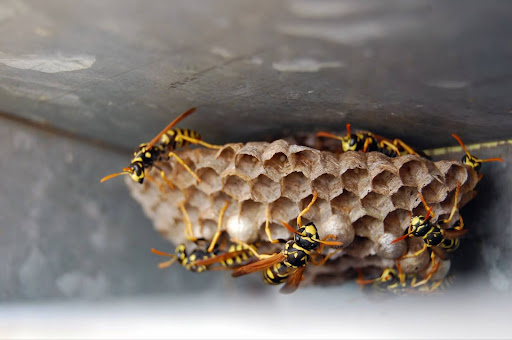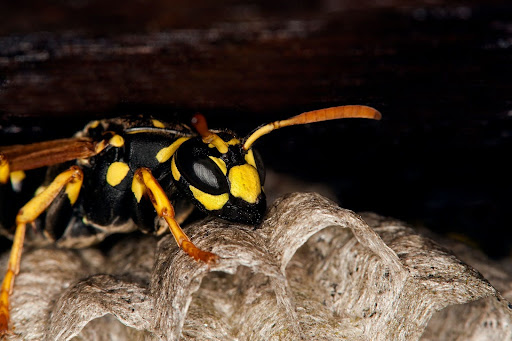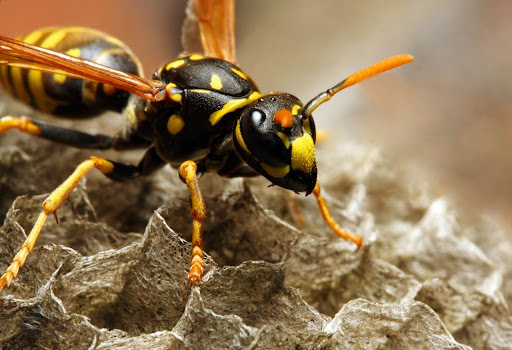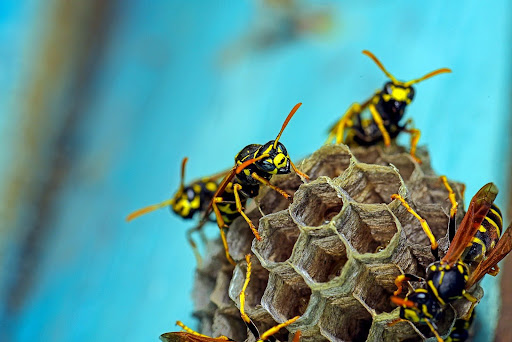Maybe it happened while you were sitting on your patio, enjoying a drink and admiring the craftsmanship of your home. Perhaps you were unloading groceries when you found yourself with a wasp resting on your arm.
Or maybe (hopefully not!) you discovered you had a wasp nest under the siding of your home when a member of your family was stung.
Wasps building nests under siding might sound like something out of a horror movie (or your worst nightmares, at the very least), but it happens more often than you might think.
If you’ve heard the hum of buzzing wings near the edge of your home or noticed wasps flying in and out of small openings, there’s a good chance you’re dealing with a hidden wasp nest. These pests are not only a nuisance but can also pose a safety risk for you and your family.
Luckily, Green Shield Pest Pros is here to help. In this post, we’ll break down why wasps choose siding for their nests, the potential dangers they bring, and how we effectively—and safely—remove them from your home.
Why Do Wasps Build Nests Under Siding?

Wasps are resourceful creatures, and your home provides everything they could need. They often choose hidden, weather-protected spaces like siding for one main reason—safety.
Siding gaps give wasps an undisturbed area to build their nests without predators or extreme weather affecting them. Wasps instinctively seek out locations that are slightly elevated and secluded, making the space between your home’s siding layers ideal.
Another factor is accessibility. Wasps only need a small entrance—sometimes just a millimeter wide—to squeeze through and establish their nest. Cracks, damaged siding, or vent openings near your roofline can all serve as the ideal entry points.
Warmth is another big attraction. The space under your siding can retain heat, especially if your home is exposed to direct sunlight for long periods. This creates the perfect conditions for wasps to thrive and expand their colonies quickly.
What Dangers Do Hidden Wasp Nests Pose?

Having a wasp nest under your siding isn’t just inconvenient—it’s risky. Wasps are highly protective of their homes and can become aggressive if disturbed. This makes even simple activities like mowing the lawn or playing in the yard potentially hazardous if you unknowingly agitate the nest.
The primary concern with wasps is their ability to sting multiple times, which differs from bees. For those of us who are allergic to wasp venom, stings can trigger serious allergic reactions, including anaphylaxis. For others, even a non-allergic reaction to wasp stings can be painful and, at the very least, distressing.
Beyond the immediate health risks, hidden nests can cause structural issues to your home. While wasps don’t eat wood like carpenter ants or termites, their activities might lead to water damage. Nest-building can block vents or drainage systems, trapping moisture behind your siding and leading to long-term damage.
What to Do About a Wasp Nest Under Siding

At Green Shield Pest Pros, we understand how worrying it is to discover a wasp infestation. That’s why we take a thorough and safe approach to remove nests while protecting you, your family, and your home.
Here, we’ll walk you through our process:
Step 1: Inspection
The first step in tackling any pest problem is understanding its scope. We’ll assess the situation to locate the nest, identify the type of wasps present, and evaluate the safest way to remove it.
Not all wasps are the same, and getting to know the exact species is an important first step, as it helps us choose the best method for effective eradication.
Step 2: Safe Nest Removal
Once we’ve determined the best plan of action, we’ll carefully remove the wasp nest. Using professional-grade tools and safety equipment, our team makes sure there is minimal risk to both you and the surrounding environment. We opt for strategies that are effective but low-risk to avoid unnecessary chemical use.
Step 3: Entry Point Sealing
After removing the nest, we don’t stop there. We’ll pinpoint how the wasps were able to get under your siding in the first place and seal off those entry points. This helps us make sure that a new colony doesn’t move in to take the place of the old one.
Step 4: Preventative Measures
Our job isn’t just to deal with your current wasp problem—it’s also to help prevent future infestations. We offer advice and solutions to protect your home, such as repairing damaged siding, installing fine mesh covers over vents, and regular pest inspections.
Protect Your Home with Green Shield Pest Pros
Green Shield Pest Pros has been serving the Columbus area for years. We’re proud to bring safe, reliable pest control solutions that prioritize your family’s comfort and peace of mind. With our team by your side, you’ll never have to face pest issues alone.
Our approach is simple: we combine expert knowledge with personalized service to deliver superior results. Don’t take our word for it—our long list of happy customers reflects the trust we’ve built throughout our community.
If you’re staring down a wasp nest under your siding, don’t wait for the problem to get worse. Green Shield Pest Pros has the knowledge, experience, and tools to keep your home safe and secure. Wasp nest removal can be dangerous if handled improperly, so leave it to the experts.
Contact us at Green Shield Pest Pros to schedule your inspection today. Together, we’ll make your home a safer, more comfortable place for your family—not for wasps.
